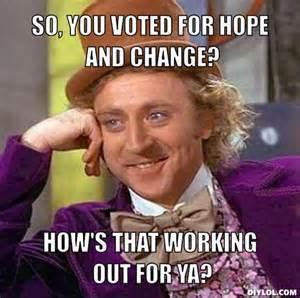
Sacramento Bee: Monica Alexander needs a full-time job (Heck, I bet the record number of people out of the workforce just wish they had any kind of job) . A certified nursing assistant, she just started working about 28 hours a week as a home companion in Wake County, N.C. That’s a major improvement over the eight hours she had been clocking each week for six of the past seven months.
Alexander is one of 7.5 million Americans struggling to find full-time work who settle for part-time jobs, amid an atmosphere of stress, depression and low finances. Their numbers remains stubbornly higher in the current economic recovery, compared with the peaks of the recessions over the past three decades.
Indeed, the number of unemployed people is 24 percent higher now than it was in December 2007 when the recession began. But the number of people like Alexander – known as involuntary part-time workers – is 66 percent higher, more than double what it was back then.
One reason is a gap in the kinds of skills needed to find work in an increasingly technological workplace. Many employers also remain uncertain about the economy and hesitant about deeper financial commitments.
And hiring part-time instead full-time employees is one way that some businesses are getting around the costs of a mandate in the health care law that requires employers with 50 or more full-time workers to provide insurance coverage beginning in January.
“The pace of decline in part-time employment is smaller now than what we’ve seen in other recoveries,” said Gus Faucher, a senior economist at PNC Financial Services Group in Pittsburgh. “Businesses have been cautious about moving workers from part time to full time.”
Alexander, 43, lives with three of her four children in Zebulon, N.C., population 4,433. They live in Section 8 housing, a type of federally subsidized low-income housing, in the Research Triangle, a region near Raleigh and Durham clustered with universities and high-tech companies. Last year she earned about $7,000.
“It’s been a struggle to keep food in the house, to keep gas in the car,” she said. “My 17-year old was making comments, ‘Well, Mom, do we really have to live like this?’”
Alexander’s monthly grocery bill for four people and their dog, Tiny, runs between $150 and $200, or roughly $12.50 per week per person. She’s reluctant to use her car to apply for jobs for fear that it will be a waste of time and money. The family supplements its income with two disability checks: one for Alexander because she is hearing disabled, and one for a son who has an attention deficit disorder.
Sometimes relatives bring food over for the children, but Alexander’s two ex-husbands pay no child support; one is unemployed and the other is in jail, she said.
Alexander is currently taking college classes to become a certified nurse by the end of next year. The classes are paid for by the Capital Area Workforce Development Board, a federally funded employment agency in Raleigh. Meanwhile, she applied for a full-time job at McDonald’s in July but has not heard back.
“You’re waiting and waiting and waiting,” Alexander said. “In the meantime you could actually starve. That’s what it feels like: ‘Am I going to starve before I get this decent job?’”
Economists stress that the monthly number of part-time workers is a volatile statistic, subject to frequent swings. In March 2010, the number of involuntary part-time workers peaked at 9.2 million. It’s now 7.5 million, five years into the economic recovery that began in 2009. Still, even that lower amount is higher than it was during the recessions of the early 1980s, ’90s and 2000s.
“It’s bad on an individual level and a part of the slow recovery,” said Heidi Shierholz, a labor economist at the Economic Policy Institute, a left-leaning think tank in Washington. “People are involuntary part time because they can’t find jobs that meet their needs.”
The number of involuntary part-time workers actually increased in 16 states between 2012 and 2013.
The level in North Carolina ticked up from 51,000 to 63,000 workers during that period, according to the latest annual averages from the Labor Department. South Carolina, Mississippi and Kansas, among others, also increased their part-time workforces.
Dominick Finelle applies for full-time work about five times a week, even though he says he might not be qualified for all of the jobs. A self-described workaholic, Finelle earned a six-figure salary for about 15 years as a freelance illustrator of book covers between the late 1980s and early 2000s. Publishers Simon & Schuster, Penguin Books USA and Time Warner printed his illustrations. Work paid well.
His hours began to steadily decline in 2005 as the publishing industry struggled and book sales declined. Finelle moved to Cary, N.C., in 2006 with his wife, Claudia, and their three children. He has worked 10-15 hours a week for the past four years.
His income fluctuates depending on his freelance work, but he earned roughly $35,000 last year. Claudia is working temporarily full time this summer teaching arts and crafts to children.
Finelle, 51, said he has run through most of his savings: “It’s running out. I’m panicking.” To make ends meet, he has delivered pizzas, worked at the local sports arena and spent last holiday season carrying packages for UPS. Finelle said he and his family can live on the rest of his savings, along with whatever work he and his wife get, for about one more year.
“I put everything into this one career. The plan B wasn’t even in the equation,” said Finelle, later adding: “All I think about is looking for work, and if I can go this month without tapping into savings.”
A skills gap and the duration of part-time employment make full-time employment hard to earn back, said Pat Sturdivant, executive director of the Capital Area Workforce Development Board, which is operated by the Wake County government.
The “I’ll-take-whatever-I-can-get,” approach allows people to survive financially, but it may hurt them when applying for full-time work, Sturdivant said. The development board helps workers obtain jobs and pays for training. The majority of people coming to the centers for employment help are between 35 and 59.
“A lot of cases what we do find is people working part-time jobs in industries that aren’t related to what they did when they were working full time,” said Sturdivant. “That also poses a challenge when you’re trying to help them find full-time work.”
The Affordable Care Act’s impact on part-time employment is harder to discern. Some economists say that the insurance mandate is not influencing the way employers are hiring this year, but one local hiring expert disagrees.
“It drives me nuts when I read these economists’ articles,” said Bruce Clarke, president and CEO of Capital Associated Industries Inc., a human resources management company in Raleigh, “because it doesn’t match at all what I’m seeing.”
Clarke’s company surveys 1,100 companies in North Carolina on salaries, hiring, wages and health care costs, among other topics. Employers already are looking to increase their part-time employment and cheapen costs on full-time workers because of the mandate, he said.
Health care coverage for one of Clarke’s full-time employees costs about $13,000 a year. On top of a salary, the costs create little incentive for employers to hire full-time workers into positions that already have low profitability, said Clarke, who emphasized his views are economically, not politically, driven.
“If I’m going to bring someone in a role that has a low margin (of profit) in it,” he said, “then it makes no economic sense to add $13,000 to the cost of that role.”

DCG

